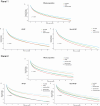A nationwide, population-based study on specialized care for acute heart failure throughout the COVID-19 pandemic
- PMID: 38837310
- PMCID: PMC11613816
- DOI: 10.1002/ejhf.3306
A nationwide, population-based study on specialized care for acute heart failure throughout the COVID-19 pandemic
Abstract
Aims: The COVID-19 pandemic disrupted the delivery of care for patients with heart failure (HF), leading to fewer HF hospitalizations and increased mortality. However, nationwide data on quality of care and long-term outcomes across the pandemic are scarce.
Methods and results: We used data from the National Heart Failure Audit (NHFA) linked to national records for hospitalization and deaths. We compared pre-COVID (2018-2019), COVID (2020), and late/post-COVID (2021-2022) periods. Data for 227 250 patients admitted to hospital with HF were analysed and grouped according to the admission year and the presence of HF with (HFrEF) or without reduced ejection fraction (non-HFrEF). The median age at admission was 81 years (interquartile range 72-88), 55% were men (n = 125 975), 87% were of white ethnicity (n = 102 805), and 51% had HFrEF (n = 116 990). In-hospital management and specialized cardiology care were maintained throughout the pandemic with an increasing percentage of patients discharged on disease-modifying medications over time (p < 0.001). Long-term outcomes improved over time (hazard ratio [HR] 0.92, 95% confidence interval [CI] 0.90-0.95, p < 0.001), mainly driven by a reduction in cardiovascular death. Receiving specialized cardiology care was associated with better long-term outcomes both for those who had HFrEF (HR 0.79, 95% CI 0.77-0.82, p < 0.001) and for those who had non-HFrEF (HR 0.87, 95% CI 0.85-0.90, p < 0.001).
Conclusions: Despite the disruption of healthcare systems, the clinical characteristics of patients admitted with HF were similar and the overall standard of care was maintained throughout the pandemic. Long-term survival of patients hospitalized with HF continued to improve after COVID-19, especially for HFrEF.
Keywords: COVID‐19; Heart failure; National Heart Failure Audit; Specialist care.
© 2024 The Author(s). European Journal of Heart Failure published by John Wiley & Sons Ltd on behalf of European Society of Cardiology.
Figures



Similar articles
-
Contemporary epidemiology of hospitalised heart failure with reduced versus preserved ejection fraction in England: a retrospective, cohort study of whole-population electronic health records.Lancet Public Health. 2024 Nov;9(11):e871-e885. doi: 10.1016/S2468-2667(24)00215-9. Lancet Public Health. 2024. PMID: 39486903
-
Clinical characteristics of hospitalized heart failure patients with preserved, mid-range, and reduced ejection fractions in Japan.ESC Heart Fail. 2019 Jun;6(3):475-486. doi: 10.1002/ehf2.12418. Epub 2019 Mar 3. ESC Heart Fail. 2019. PMID: 30829002 Free PMC article.
-
Heart Failure Specialist Care and Long-Term Outcomes for Patients Admitted With Acute Heart Failure.JACC Heart Fail. 2025 Mar;13(3):402-413. doi: 10.1016/j.jchf.2024.06.013. Epub 2024 Aug 7. JACC Heart Fail. 2025. PMID: 39115521
-
Atrial fibrillation and risk of adverse outcomes in heart failure with reduced, mildly reduced, and preserved ejection fraction: A systematic review and meta-analysis.J Cardiovasc Electrophysiol. 2024 Apr;35(4):715-726. doi: 10.1111/jce.16209. Epub 2024 Feb 13. J Cardiovasc Electrophysiol. 2024. PMID: 38348517
-
A year in heart failure: an update of recent findings.ESC Heart Fail. 2021 Dec;8(6):4370-4393. doi: 10.1002/ehf2.13760. Epub 2021 Dec 16. ESC Heart Fail. 2021. PMID: 34918477 Free PMC article. Review.
References
-
- National Institute for Cardiovascular Outcomes Research (NICOR) . National Heart Failure Audit 2019 Summary Report 2019. https://www.hqip.org.uk/wp‐content/uploads/2019/09/Ref‐129‐Cardiac‐Heart... (2 May 2024).
-
- McDonagh TA, Metra M, Adamo M, Gardner RS, Baumbach A, Böhm M, et al. 2021 ESC Guidelines for the diagnosis and treatment of acute and chronic heart failure: Developed by the Task Force for the diagnosis and treatment of acute and chronic heart failure of the European Society of Cardiology (ESC). With the special contribution of the Heart Failure Association (HFA) of the ESC. Eur J Heart Fail 2022;24:4–131. 10.1002/ejhf.2333 - DOI - PubMed
-
- Vaduganathan M, Claggett BL, Jhund PS, Cunningham JW, Pedro Ferreira J, Zannad F, et al. Estimating lifetime benefits of comprehensive disease‐modifying pharmacological therapies in patients with heart failure with reduced ejection fraction: A comparative analysis of three randomised controlled trials. Lancet 2020;396:121–128. 10.1016/S0140-6736(20)30748-0 - DOI - PubMed
MeSH terms
Grants and funding
LinkOut - more resources
Full Text Sources
Medical
Research Materials
Miscellaneous

